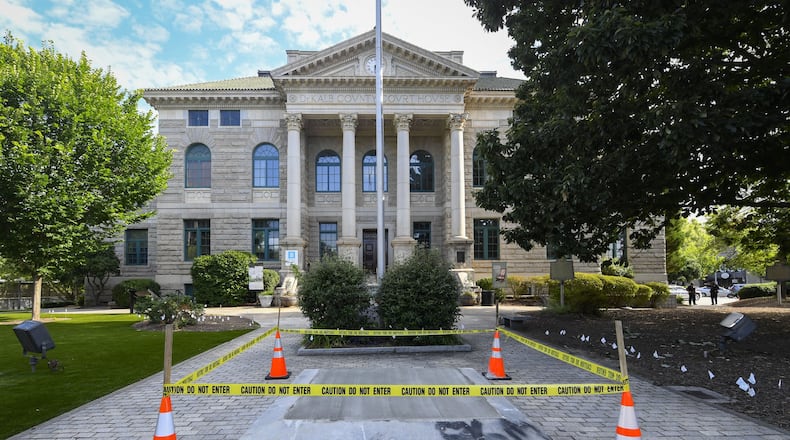Last month, dozens of protesters squared off against 50 police officers in riot gear at the state Capitol and began to chant.
“Tear down Gordon! Tear down Gordon!”
The target of their ire was the regal figure of Confederate Gen. John Brown Gordon, a former Georgia governor, senator and a white supremacist who is generally regarded as a state leader of the Ku Klux Klan in the years following the Civil War.
The statue depicts Gordon in his Confederate uniform astride his horse, and has held a prominent spot on the statehouse lawn since its unveiling 113 years ago to a throng of white Atlantans and a band playing, “Dixie.”
» PHOTOS: Confederate monuments in Atlanta
Gordon remains, but Confederate statues across the southeast are falling, including the court-ordered removal of a 112- year-old obelisk from the Decatur square June 12. Gone, too, is the contextual marker, placed just last year, that informed visitors the monument was erected to "glorify the 'lost cause' of the Confederacy."
Likewise, on June 30 Rockdale County removed a 1913 Confederate monument from the courthouse lawn in Conyers, and officials in Henry County officials voted Tuesday to take down the memorial on McDonough square.
While President Trump and others have called the removals an attempt to erase American history, historians have long discounted Confederate memorials as accurate representations of the Civil War.
Erected in most cases decades after the war ended, the monuments better illustrate how white southerners sought to rewrite history and impart noble motives to the dead, they say.
“I’ve been studying history in some ways all my life. I’ve been doing it professionally for over 30 years, and I can’t say that I’ve ever learned much history at all from a monument,” said Kenneth Noe, Draughon Professor of Southern History at Auburn University. “Those aren’t the sources we use.”
» MORE: Confederates honored at Georgia's capitol
University of Alabama history professor Hilary Green was succinct.
“Monuments do a very poor job in talking about history,” she said.
The Atlanta Journal-Constitution spoke to five historians who specialize in Civil War and Southern history about calls to remove Confederate statues many consider a vestige of segregation and white supremacy. William Sturkey, a professor of Southern history at the University of North Carolina at Chapel Hill, said white Southerners erected the monuments decades after the Civil War in a bloody campaign to reassert white supremacy and strip Blacks of newly earned freedoms.
“People that make the argument that taking down monuments is erasing history truly have no idea how much history has been erased,” he said. “These activist organizations (who erected the monuments) sought to reshape history, reshape the meaning behind the Civil War, reshape what happened during Reconstruction, reshape the participation of African Americans in the history of this region and in our country. Those were the people who were actually erased.”
More and more local leaders are reflecting that academic perspective as they confront controversies over memorials in their own communities. Last month, the Kennesaw City Council approved a resolution removing the Confederate battle flag from a war memorial on the city's Main Street. Mayor Derek Easterling said the decision was met with overwhelming approval from local residents. He said addressing these monuments isn't erasing history.
“Removing a statue is not going to change how people feel,” he said. “It’s not going to change what happened.”
But he said local leaders can take actions to address the message monuments send. In the case of Kennesaw, the council removed the Confederate battle flag, replacing it with the flag flown during the Civil War, an action designed to remove the most controversial element of the display.
An historical reckoning
Thomas Brown, a history professor at the University of South Carolina and scholar on the role of monuments in American culture, said the ground is shifting rapidly since the death of George Floyd in Minneapolis refocused the nation’s attention on institutional racism. And popular opinion on the meaning and relevance of Confederate memorials has shifted too, he said.
“The community that put up the John Gordon statue in 1907 is not the community that will debate it’s fate today,” he said. “I do think it could be a healthy discussion for Atlanta now.”
Forty-four of Gordon’s living descendants are among those who have joined the discussion, noting in a letter to Gov. Brian Kemp that the “primary purpose of the statue was to celebrate and mythologize the white supremacists of the Confederacy.” The descendants want Kemp to remove it.
Legally removing Confederate monuments in Georgia is difficult. A Senate bill Kemp signed last year forbids the removal of monuments, markers, plaques and place names dedicated to "historically significant military, religious, civil, civil rights, political, social, or cultural events or series of events" or to honor military service, including in the Confederate Army. And it stiffened penalties for anyone who vandalizes a monument.
Yet, elsewhere in the Deep South, authorities are moving ahead. Last month, the University of Alabama removed a plaque and memorial boulder placed by the United Daughters of the Confederacy in 1914 on the campus quad.
Alabama has a law protecting monuments as well, but the university found a loophole in the law that allowed the removal of the memorial boulder. Similarly, DeKalb County removed the Lost Cause obelisk after a judge declared it a public nuisance.
DeKalb County CEO Michael Thurmond, who has written books about Georgia history, ordered the removal of the monument, but he dismisses the idea that history is being erased.
“I’ve spent a major portion of my adult life and even earlier researching and writing about the American Civil War. For me, it was and remains the defining moment in the history of our nation,” he said.
But he said the monuments that were erected after the end of Reconstruction were put there to romanticize the South’s role in the Civil War as a heroic struggle, rather than a fight to preserve slavery.
“The Southerners fought valiantly, but they fought for the worst cause any people have ever fought for,” he said. “There has to be some reckoning with that fact.”
Lost Cause ideology
Karen Cox, a history professor at the University of North Carolina at Charlotte, said historians have been “slow on the uptake” in considering the fate of the more than 700 Confederate monuments spread across the South.
“There really (hadn’t) been a lot of discussion among historians until the Charleston massacre,” she said, referring to the June 17, 2015, mass murder of nine African Americans in a Black church in Charleston by a white supremacist.
Noe said he believes the opinion of historians has evolved over the past five years.
“If you had asked me several years ago what do we do with the monuments, I would have said, ‘Interpret them.’ That’s what we historians do, right? We interpret the past,” he said. “That has largely been rejected, and it was rejected by both sides.”
Some of the outrage following the attack in Charleston slayings focused on symbols like the Confederate battle flag, the carving at Stone Mountain and several high-profile Confederate memorials from Richmond to Birmingham to New Orleans. Cox, who has published books on the movement to erect the monuments, said most of them were erected between 1890 and World War I as whites in Southern states sought to reassert their political and social dominance following Reconstruction.
Cox said the monuments do have a historical meaning, just not for the Civil War.
“What it teaches us is about the history of the Jim Crow period,” she said. “What it’s about is the generation of people who put those monuments up, who attended the unveilings, etc. It’s about their desire to memorialize the Confederacy and Confederate principles — things like states rights, things like white supremacy.”
She said white leaders sent a distinct message to the Black community by placing many of the statues in front of the courthouse where trials were held and citizens registered to vote.
“These monuments only represent a particular version of history. It’s one that is crafted in Lost Cause ideology,” she said, referring to the idea that the South cause in the Civil War was noble and just. “It’s not history as much as it is myth-making.”
“They certainly speak to the culture of the times,” added Noe. “But it was a culture in which one segment of the population dominated another.”
Before the flood of Civil War monuments were erected, Americans did not have much of a history of building such memorials.
“John Quincy Adams famously said, ‘Democracy has no monuments. It strikes no metals,’” Brown said. For example, Benjamin Franklin, perhaps the most universally admired of the Founding Fathers after George Washington, had no statue to his memory until the mid-1850s. “It was a cultural form that had been developed in monarchical and imperial orders.”
First markers in the North
The soul-shaking death count of the Civil War changed that.
“So many people died,” Brown said. “They died far from home, away from their families, violently at a young age, and most importantly of all, their bodies didn’t come back.”
To commemorate the lost, Brown said local leaders began erecting monuments — in the North. “It is death that puts the public monument on the national landscape,” he said.
But the proliferation of monuments decades later in the South took a somewhat different tone. And it did not go unnoticed by the newly freed African Americans and their children, Green said.
“From the very beginning African Americans were openly hostile to this landscape because it is occurring in the time with disenfranchisement. It also is occurring in a time with lynching. It’s also coming at a time where Jim Crow realities are becoming real and that moment of Reconstruction is closing,” she said. “They are seeing themselves being erased.”
UNC Professor Sturkey said African Americans resisted the erection of monuments “from the jump.” He pointed to one instance in Chatham County, North Carolina, more than a century ago.
“Their Confederate monument was defaced within 10 days of going up in the early 1900s,” he said. “It was an African American who climbed the Confederate monument and poured tar over its face to protest the erection of that particular monument.”
Green said that historical unrest is important to consider. While diverse groups of white and black protesters are gathering around monuments in cities across the nation, there has always been protest by Blacks who saw them as symbols of lost freedoms.
“People rejected these from the beginning. These were never uncontested, neutral sites, and it is showing today,” she said.
But as monuments fall, exciting cheers or boos from various corners, Green believes this is only the start of the labor of knitting a new American identity.
“Taking down monuments is easy. Putting up monuments is easy. But having those difficult conversations that undergird the activists that led to the toppling? That’s the hard part. That’s going to take more time,” she said. “This is the start, not the end, of the conversation.”
The AJC spoke to a panel of experts on Civil War and Southern history. They are:
Thomas Brown
Professor of Civil War and Reconstruction history at the University of South Carolina
Author of “Civil War Monuments and the Militarization of America,” winner of the 2020 Tom Watson Brown Book Award by The Society of Civil War Historians and the Watson-Brown Foundation.
Karen Cox
Professor of Southern history and culture at the University of North Carolina at Charlotte
Author of “Dixie’s Daughters: The United Daughters of the Confederacy and the Preservation of Confederate Culture” and the forthcoming book “No Common Ground: Confronting the Legacy of Confederate Monuments.”
Hilary N. Green
Associate professor of history in the Department of Gender and Race Studies at the University of Alabama
Author of “Educational Reconstruction: African American Schools in the Urban South, 1865-1890”
Kenneth Noe
Draughon Professor of Southern History at Auburn University
Author of “Perryville: This Grand Havoc of Battle” and the forthcoming book “The Howling Storm: Weather, Climate, and the American Civil War”
William Sturkey
Assistant professor of history at the University of North Carolina Chapel Hill
Author of “Hattiesburg: An American City in Black and White.”
About the Author
Keep Reading
The Latest
Featured









